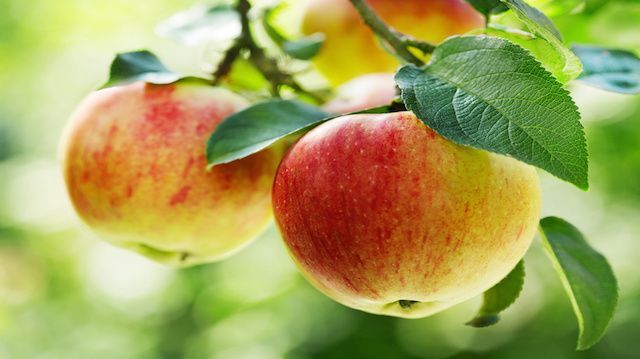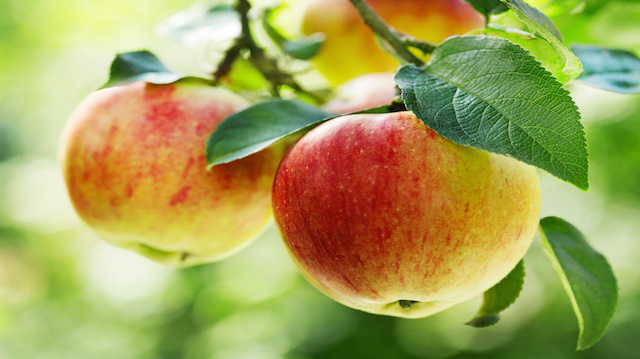
An apple a day may still keep the doctor away — especially for kids. Increasing children’s interest in fruit is important for healthy growth and development, but what about apple juice, or any fruit juice for that matter? A recent study published in Pediatrics (2015) analyzed the eating habits of 3,128 children between the ages of two and 19 years old and found apples are the favored fruit among kids. This is excellent since apples are an exceptional source of fiber and vitamin C.
The 2015 study utilized the National Health and Nutrition Examination Survey to assess what children eat. Researchers calculated the consumption of “whole fruit, 100% fruit juices, mixed fruit dishes, and 12 discrete fruit and fruit juices to total fruit consumption.”
The research found that apples account for 18.9 percent of fruit consumption by kids in America. The study also noted that apple juice, bananas, and citrus juice were among other fruits and fruit juices at the top of the list, with kids consuming 1.25 cups of fruit daily. This is great news, considering kids should be eating one to two cups of fruit per day, according to the U.S. Department of Agriculture’s 2010 dietary guidelines.
There was also mention of fruit juice consumption in the study, which is cause for concern. The study found that 53 percent of fruit consumption came from whole fruits while 34 percent was attributed to fruit juice intake. Fruit juices are often loaded with fructose and sugar, two culprits in the American obesity crisis. Fruit juices can sometimes be more detrimental than soda. Yes, there are vitamins and minerals in fruit juices, but an eight-ounce glass will increase sugar and fructose levels to 50 percent of the Daily Value (DV).
“Liquid forms of calories have been shown to bypass many satiety cues and may contribute to excess caloric intake because people may not compensate for calories consumed in liquid form,” the study warned. This is in fact a real issue, and one that many Americans are not aware of when they purchase fruit juice at the store.
A 2008 study published in The Medscape Journal of Medicine analyzed fructose calorie intake of American adults and children. Fructose consumption accounted for 10.2 percent of calorie intake per day. The study also found that fructose intake was higher in children between ages 12 and 18, who consumed 72.8 grams of fructose per day, which is 12.1 percent of their daily calories.
 It is great news that children are getting their recommended amount of fruit per day, but we must make sure that fruit consumption comes from real fruit in order to decrease fructose and calorie intake. In the past 30 years, childhood obesity has doubled, and obesity has quadrupled in adolescents. According to the Centers for Disease Control and Prevention (CDC), 18 percent of children and 21 percent of adolescents are obese. These rates are alarming, especially when we know that obesity leads to a number of chronic diseases.
It is great news that children are getting their recommended amount of fruit per day, but we must make sure that fruit consumption comes from real fruit in order to decrease fructose and calorie intake. In the past 30 years, childhood obesity has doubled, and obesity has quadrupled in adolescents. According to the Centers for Disease Control and Prevention (CDC), 18 percent of children and 21 percent of adolescents are obese. These rates are alarming, especially when we know that obesity leads to a number of chronic diseases.
The CDC states, “Obese youth are more likely to have risk factors for cardiovascular disease, such as high cholesterol or high blood pressure. In a population-based sample of 5- to 17-year-olds, 70% of obese youth had at least one risk factor for cardiovascular disease.”
An excellent alternative to store-bought juice is homemade fruit juice or a smoothie mixed with veggies. Children won’t even notice the veggies hidden in blended, natural fruit. Keeping a close eye on portions is also vital. Think about how many fresh oranges it takes to fill up a glass with orange juice. That’s a lot of oranges!
Do you and your family get your recommended daily intake of fruit? Does it come from whole fruit or fruit juice?
—Stephen Seifert
Stephen Seifert is a writer, professor, adventurer and a health & fitness guru. His flair for travel and outdoor adventure allows him to enjoy culture and traditions different than his own. A healthy diet, routine fitness and constant mental development is the cornerstone to Stephen’s life.
Sources:
http://www.cnpp.usda.gov/DietaryGuidelines
http://pediatrics.aappublications.org/content/early/2015/09/15/peds.2015-1709
https://www.aap.org/en-us/about-the-aap/aap-press-room/pages/New-Study-Shows-Exactly-What-Kind-of-Fruits-Children-Like-to-Eat-Apple-is-1.aspx
http://www.cdc.gov/healthyschools/obesity/facts.htm
http://www.ncbi.nlm.nih.gov/pmc/articles/PMC2525476

